Adding the personal touch
October 4, 2007
As part of the fitness assessment, the personal trainer measures the client for height, weight, heart rate and strength. Heather Stawicki, Daily Kent Stater
Credit: Jason Hall
When I think of a personal trainer, I think of the high-priced fitness gurus who celebrities hire to shed baby weight or get in shape for their next movie. Being more of the bookish type, I was never one to get excited about the prospect of paying someone to watch me exercise. But, being the dedicated reporter that I am, I took the plunge and signed up.
The personal training program at the Student Recreation and Wellness Center is a three-step process and, like everything else, starts out with paperwork.
You answer standard questions that determine if you’re healthy enough to start a personal training regime and fill out several questionnaires about current lifestyle, personal nutrition and fitness goals.
Step 1: The Fitness Assessment
The fitness assessment is required for starting a personal training program. It gives the trainer a better idea of how to customize an exercise plan.
After the paperwork was done, I met my fitness assessment instructor and personal trainer, senior exercise science major Scott Habowski. We went into a small room in the Fitness Suite of the center where he took my height and weight.
Next, he checked my body fat percentage, which showed how much of my weight is fat. He pinched as much fat as he could from my arm, hip and thigh. And, of course, he had to do it twice.
After finding out, literally, how fat I am, it was time for the aerobic assessment. This test gives the trainer an idea of where your heart rate should be during training. A heart-rate monitor was placed underneath my shirt and around my wrist. I pedaled on a blue exercise bike to the click of a metronome.
Click. Click. Click. Awkward silence as my face turned red and my heart rate jumped to 160 beats per minute. The length of the assessment depends on your aerobic fitness, and can last from four to 10 minutes. I pedaled for six.
Finally, I hopped off the bike and it was time to determine my strength, muscular endurance and flexibility. Strength was determined through hand grip strength and how much weight I could press. Muscular endurance was tested with push-ups and sit-ups. Flexibility is how far forward one can reach with his or her legs straight out.
The final assessment: I need to get off my lazy butt and get to the gym.
Step 2: Nutrition Diet Analysis
The second step of personal training is a half-hour nutrition diet analysis with nutritionist Rose Ann Chiurazzi.
The analysis is important because “if a person is not eating right, then they won’t be getting the benefits (of exercise), they’ll lose energy and it will affect how they feel,” Chiurazzi said.
She went through my questionnaire asking me about my current eating habits and weight loss goals. She also told me how many calories I need to eat a day in order to lose the weight that I want.
She then gave me an overview of healthy eating habits and stressed hydration.
“I always stress drinking water,” she said. “People who drink eight glasses a day or more tend to lose more weight and feel better.”
The session ended with a few handouts to help me remember all that we talked about, and I felt that I can live a healthy lifestyle while constantly being on the go.
Step 3: Training
Based on the results of the fitness assessment, Habowski made me a personalized fitness plan.
Habowski demonstrated every exercise and made each one look easier than the next. He showed me how to properly use the machines and equipment because, often, people don’t know how to workout properly.
We used the rowing machine, incline press and free weights to work my arm muscles. Abdominal muscles were next. We used the stability ball, medicine ball and the ground to tone my hidden six-pack. We didn’t do cardio because it could be done on my own time.
“I don’t usually do cardio during a session,” Habowski said. “I don’t want people to pay me to stand there and watch them run.”
Personal training is for people who are serious about changing their lifestyle and achieving their fitness goals. Sessions are not cheap, and participants should come in with specific goals in mind, whether it’s to learn how to exercise, lose weight or run a 10K race.
Contact Student Recreational and Wellness Center reporter Katelyn Luysterborg at [email protected].
















